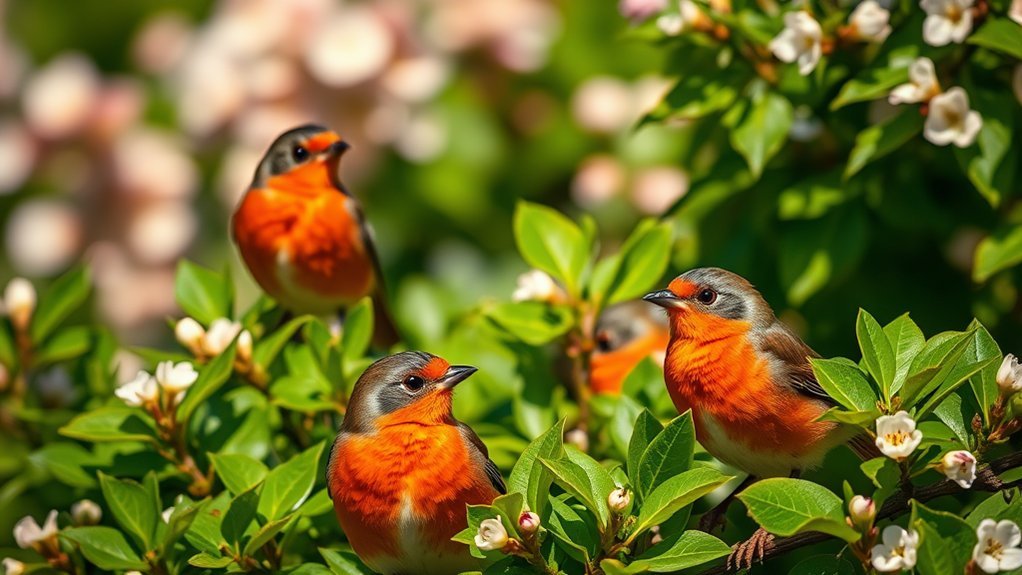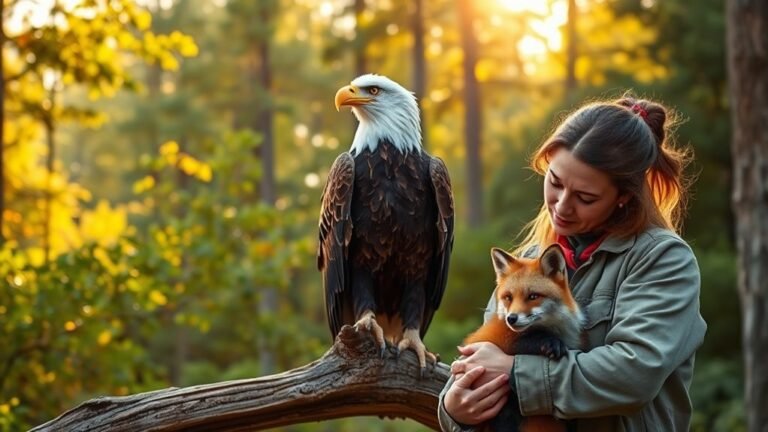Birds That Look Like Robins: Red-Breasted Mimics
Many birds look like robins, especially due to their reddish-orange breasts. For example, the American and Eurasian robins have different colors and live in separate habitats. Watching their behaviors can show us how they adapt to their environments. Other birds, like the Varied Thrush and Eastern Bluebird, also share similar features and interesting traits. Their unique characteristics add depth to this birdwatching experience.
Key Takeaways
The American Robin has a reddish-orange breast and is commonly seen in North American backyards and gardens. The Eurasian Robin also has an orange-red breast, but it features a grey back and is prevalent in Europe. The Varied Thrush displays an orange chest and dark blue wings. This bird is often found in the forests of the Pacific Northwest and shares similar colors with the robin. Eastern Bluebirds have bright blue feathers and are usually seen in open fields. They resemble robins in appearance. The Hermit Thrush is brown, yet it shares a slight resemblance with robins. This bird is known for its beautiful songs in dense forests.
The Charming American Robin
The American robin is easily identified by its reddish-orange breast, but it has many interesting traits.
In spring, you can see robins hopping around yards as they search for insects and worms. They've unique methods for locating food, like tilting their heads to listen for sounds beneath the ground.
Robins also have fascinating nesting habits. They build nests in trees or shrubs using mud and grass for support.
You might notice a robin caring for its young, which shows their strong parental instincts. Watching these behaviors helps you appreciate the beauty and wonder of nature.
The Eurasian Robin: A European Counterpart
The American robin is common in North America, while the Eurasian robin is a charming sight in Europe. This songbird lives in various habitats, including gardens and forests.
Its orange-red breast stands out against its grey back. Eurasian robins are known for their beautiful songs. They sing in the early morning, inviting us to enjoy their presence.
These birds are curious and often approach people. Watching them can connect you to nature and enrich your experiences in Europe. As you explore, listen to their sweet songs, which blend harmoniously with their environment.
The Varied Thrush: An Enigmatic Look-Alike
If you walk through the dense forests of the Pacific Northwest, you may see the Varied Thrush. This bird looks similar to the American robin. It has bright orange on its chest and dark blue wings, which attract attention.
The Varied Thrush has a unique pattern on its head. It often finds food on the ground, looking for insects and berries. You usually find this bird in wet, mature forests that support a variety of plant and animal life.
Its flute-like song fills the woods, especially during breeding season, adding beauty to the natural environment. Spotting a Varied Thrush can enhance your appreciation for nature and its connections.
The Eastern Bluebird: A Splash of Color
When you see an Eastern Bluebird in open fields or near rural fences, their bright colors stand out.
These birds live in environments with open grasslands, orchards, and scattered trees. Their blue feathers blend well with the sky and greenery, helping them hide from predators.
As you watch them, you'll see their playful movements as they quickly dive to catch insects or grab berries from bushes.
During their breeding season, male bluebirds fly in the air to impress females.
This mix of vivid color and lively actions helps you enjoy the beauty of nature and feel connected to your surroundings.
The Hermit Thrush: A Subtle Mimic
The Hermit Thrush has brown feathers that help it blend into its surroundings. However, its song is beautiful and captivating. This bird prefers moist, dense forests with lots of underbrush and berry bushes.
Its song is soft and resembles flute notes. The Hermit Thrush often sings from low branches. This position helps the sound travel and adds richness to its melody.
When foraging on the ground, the bird moves subtly, revealing its shy nature.
Watching the Hermit Thrush can be rewarding for those who are patient, as it offers a glimpse of the simple beauty found in nature.
The American Redstart: Vibrancy in the Underbrush
The American Redstart is a vibrant bird found in North American woodlands. It has striking black and orange feathers. You can see it moving quickly through the underbrush, captivating birdwatchers with its lively behaviors.
Here are its preferred habitats:
- Deciduous forests: The American Redstart enjoys areas with broadleaf trees.
- Shrubby regions: Dense plants provide great spots for catching insects.
- Riparian zones: Being near water helps meet their food needs.
- Thickets: Thick undergrowth offers shelter for nesting and safety.
Watching this bird is a reminder of nature's beauty.
The American Redstart plays an important role in its ecosystem and is truly a gem of the forest.
The Scarlet Tanager: A Distant Relative
The Scarlet Tanager is closely related to the American Redstart. It stands out in North American forests with its bright red body and black wings.
In spring and summer, you can easily spot these birds in deciduous trees. They prefer habitats rich in resources.
Scarlet Tanagers mainly eat insects and fruits, helping local ecosystems thrive. During migration, thousands travel from eastern North America to Central America for the winter.
Watching a Scarlet Tanager in nature highlights the beauty and diversity of birds. Their vibrant colors invite you to explore the outdoors and appreciate nature's wonders.
Frequently Asked Questions
What Habitats Do These Robin-Like Birds Prefer?
Robin-like birds thrive in many habitats, including woodlands and urban gardens. They show flexibility in nesting preferences. These birds adapt to various environments as they look for safety and food for their young. Their presence in different areas highlights their ability to thrive in a range of conditions, making them interesting to observe in both natural and human-made spaces.
How Can I Distinguish Between These Birds and Actual Robins?
To tell these birds apart from actual robins, focus on their colors. These birds may have duller tones or different shades. Pay attention to their songs, as their calls usually sound different from a robin's song. Observing these features will help you identify the birds accurately.
Are These Birds Migratory or Resident Species?
You are likely seeing different migration patterns in these birds. Some birds stay in their areas all year, while others move to different locations with the seasons. Knowing these behaviors can improve your birdwatching enjoyment and help you connect more with nature.
What Do These Birds Eat in Their Natural Habitat?
In their natural habitat, these birds show various foraging behaviors. They eat insects, fruits, and seeds. Their food choices change with the seasons to ensure they get the nutrients they need. This adaptability helps them thrive in different environments.
How Can I Attract Them to My Backyard?
To attract birds to your backyard, set up bird feeders with seeds and berries. Add native plants to your garden that offer natural food sources. This creates a friendly space for birds to visit often. Enjoy watching them come and go as they find food and shelter in your garden.

Ava is a bird enthusiast and nature lover who has spent countless hours observing and learning about the fascinating world of birds. With a passion for sharing her knowledge and inspiring others to appreciate the beauty of birds, Ava writes about her experiences and insights on avianadmirer.com.







